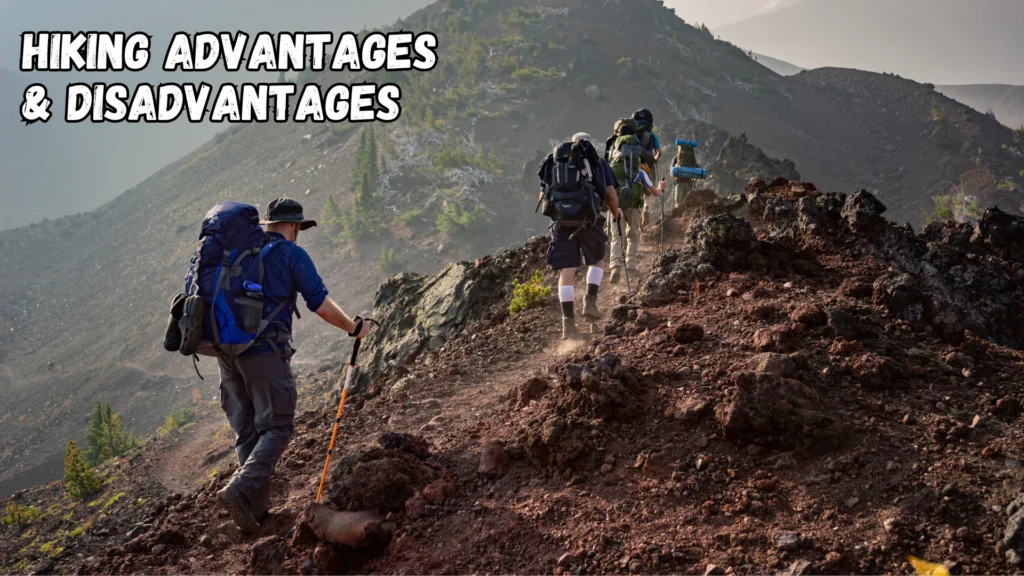Trekking poles have pros and cons for hiking – they provide stability and reduce joint stress, but can also be cumbersome and unnecessary for some hikers. Hiking with trekking poles offers several benefits, including improved balance and stability on uneven terrain, reduced strain on the joints and knees, and increased upper body workout.
On the downside, trekking poles can be bulky and add weight to your pack, may limit your arm movement on steep climbs, and are not always necessary on easy trails. Considering your hiking goals and personal preferences is important when deciding whether or not to use trekking poles.
While they can greatly enhance your hiking experience, they may not be a suitable choice for everyone.
Credit: www.thewildestroad.com
Benefits Of Hiking With Trekking Poles
When hitting the trails, using trekking poles can greatly enhance your hiking experience. Let’s explore the advantages of incorporating these versatile tools into your outdoor adventures.
Increased Stability
- Trekking poles provide added stability on uneven terrain.
- They help distribute weight evenly to prevent slips.
- Improves balance and reduces the risk of falls.
Reduced Impact On Joints
- Trekking poles absorb shock to protect knees and ankles.
- Eases strain on lower body joints during descents.
- Minimizes pressure on joints, ideal for those with arthritis.
Improved Endurance
- Aid in maintaining a consistent pace for longer durations.
- Lessens fatigue by offloading some of the body’s weight.
- Offers support for uphill sections to conserve energy.
Drawbacks Of Hiking With Trekking Poles
While hiking with trekking poles can offer numerous benefits, there are also some drawbacks to consider before hitting the trails.
Added Weight To Carry
Trekking poles add extra weight to your pack, which can be tiring on long hikes.
Limited Hand Mobility
Using trekking poles can restrict your hand mobility and make it challenging to perform certain tasks while hiking.
Initial Learning Curve
There is a learning curve when it comes to using trekking poles effectively, which may cause some initial discomfort or difficulty.
Choosing The Right Trekking Poles
- Material And Weight
- Adjustability And Locking Mechanism
- Handle And Grip
How To Use Trekking Poles Correctly
Trekking poles can provide many benefits while hiking. They offer stability, reduce strain on joints, and increase endurance. However, they can be cumbersome and restrict hand movement. It is important to learn proper techniques and adjust the poles to the correct height to experience the advantages without the drawbacks.
Using trekking poles can greatly enhance your hiking experience, providing extra stability, reducing strain on your joints, and assisting with balance. However, to fully enjoy these benefits, it’s important to use trekking poles correctly. Here are the key aspects you should focus on:
Proper Length Adjustment
One of the most crucial steps in using trekking poles correctly is adjusting their length to suit your height and the terrain you’ll be hiking on. To do this, follow these steps:
- Stand up straight with your arms relaxed at your sides and hold the pole upside down, gripping it just below the handle.
- Adjust the pole’s length until your elbow forms a 90-degree angle.
- Make sure to keep in mind that uphill sections might require shorter poles, while downhill sections may require longer ones for optimal support and balance.
Correct Placement And Movement
Placing and moving your trekking poles correctly is vital for maintaining stability and distributing your weight efficiently. Follow these guidelines:
- Start by slightly planting the pole in front of you as you step forward, ensuring the tip maintains contact with the ground.
- As you swing your opposite leg forward, use the pole’s momentum to push off and propel yourself forward.
- Maintain a natural rhythm, syncing your pole placement with your stride, and keep your grip relaxed but firm to maximize control.
- Remember to also adjust your pole placement when ascending or descending slopes to provide the most support.
Utilizing Straps For Support
The straps on your trekking poles are there for a reason, and utilizing them correctly can significantly improve your hiking experience. Here’s how to make the most of them:
- Slide your hand up through the strap from underneath, allowing it to rest against your palm.
- Adjust the strap so that it fits snugly around your wrist, providing support without cutting off circulation.
- When gripping the pole, avoid putting excessive pressure on your thumb or fingers by relying on the strap to bear most of your weight.
- This allows you to maintain a more relaxed grip, reducing the risk of developing blisters or hand fatigue over long hikes.
Remember, using trekking poles correctly requires practice and adjusting to your personal preferences. By focusing on proper length adjustment, correct placement and movement, and utilizing the straps effectively, you can optimize your hiking experience and enjoy the benefits of trekking poles to the fullest.
Environmental Impact Of Trekking Poles
Hiking with trekking poles can have both positive and negative environmental impacts. It’s important to consider how these tools affect the natural surroundings.
Trail Erosion And Damage
Trekking poles can contribute to trail erosion, especially on softer ground or in sensitive ecosystems. Constant poking and prodding can dislodge rocks and soil, leading to trail degradation.
Wildlife Disturbance
Trekking poles can create noise and vibrations that may startle wildlife, disrupting their natural behaviors and causing stress. It’s important to be mindful of the impact on the animals that inhabit the hiking areas.
Leave No Trace Practices
When using trekking poles, it’s essential to adhere to “Leave No Trace” principles. This includes minimizing your impact on the environment, packing out all waste, and respecting wildlife and natural habitats.
Incorporating Trekking Poles Into Different Terrains
Discover the advantages and drawbacks of using trekking poles across diverse terrains. From providing stability on rocky trails to reducing impact on the knees during descents, trekking poles offer support and balance. However, they may hinder natural arm movement and add weight to your pack, so it’s essential to consider the terrain and your hiking style before incorporating them into your adventure.
When it comes to hiking, choosing the right equipment can make a huge difference in your overall experience. One such piece of equipment that has gained popularity among hikers is trekking poles. These poles, similar to ski poles, can provide stability, balance, and support on various terrains. However, it is essential to understand how incorporating trekking poles can affect your hiking journey on different types of terrains.
Rocky And Uneven Surfaces
Hiking on rocky and uneven surfaces can be challenging for both experienced and novice hikers. Trekking poles can be extremely beneficial in these terrains. They offer additional stability and help distribute your weight evenly, reducing strain on your legs and joints. With each step, you can use the poles to carefully navigate the uneven ground, reducing the risk of tripping or falling.
Hilly And Steep Paths
Steep and hilly paths can put immense pressure on your knees and leg muscles. Incorporating trekking poles into these terrains can help alleviate some of the strain. As you ascend, you can plant the poles firmly into the ground and use them to push yourself forward. This action can provide the necessary balance and support, allowing you to make steady progress while reducing the impact on your knees.
Muddy And Slippery Conditions
When hiking in muddy or slippery conditions, trekking poles can be a true lifesaver. They provide an additional point of contact with the ground, enhancing your stability and preventing slips and falls. By driving the poles into the muck or loose soil, you can establish a firmer grip, ensuring greater traction. Trekking poles with rubber tips are particularly effective in such conditions as they offer excellent grip and prevent sinking into soft terrain.
Tips For Maintaining And Caring For Trekking Poles
When it comes to hiking with trekking poles, there are notable benefits and drawbacks. However, regardless of your stance on using trekking poles, proper maintenance and care are essential to ensure their longevity and performance on the trail. In this section, we will discuss some essential tips for maintaining and caring for your trekking poles.
Cleaning And Lubricating
Regular cleaning of your trekking poles is crucial to prevent the buildup of dirt and debris, which can affect their functionality. Use a damp cloth to wipe down the poles after each hike, paying particular attention to the locking mechanism and tips. Additionally, lubricating the locking mechanisms and joints with silicone-based lubricant can help sustain smooth extension and retraction.
Inspecting For Damage
Regularly inspect your trekking poles for any signs of damage, such as cracks, bends, or broken tips. Check the locking mechanisms for any wear or tear and ensure they are functioning properly. Any identified issues should be addressed immediately to prevent further damage and ensure safety on the trail.
Storing Properly
Proper storage of trekking poles is essential to prevent damage and maintain their integrity. When not in use, store them in a cool, dry place away from direct sunlight and moisture. For long-term storage, consider detaching the pole sections to relieve tension on the internal cords and prolong their lifespan.
Credit: www.hikingshack.com
Alternatives To Trekking Poles
Walking Sticks: Walking sticks are a lightweight and cost-effective alternative to trekking poles.
Hydration Packs with Pole Attachments: Hydration packs that come with pole attachments offer convenience for hikers.
Trekking Pole Rentals: Renting trekking poles is an affordable option for occasional hikers.
Credit: thebackpackguide.com
Considering the pros and cons, choosing to bring trekking poles on your hiking adventures can depend on your personal preferences and needs. While they offer stability and reduced strain, they may also add weight and require extra effort. Ultimately, the decision to use trekking poles comes down to individual comfort and effectiveness for each hiker.
FAQs:
Should I Use Trekking Poles When Hiking?
Trekking poles provide stability, reduce strain on joints, improve balance, and help distribute weight evenly while hiking. They are recommended for added support on challenging terrains and long hikes.
What Are Cons Of Using Trekking Poles While On Trail?
Cons of using trekking poles include added weight to carry, potential for getting caught in brush, and limited hand mobility.
Is It Better To Hike With Or Without Poles?
Hiking with poles can provide added stability and reduce strain on your joints. It can also help with balance and provide support on uneven terrain. However, some hikers prefer to go without poles for a more natural feeling and freedom of movement.
Ultimately, it depends on individual preference and hiking conditions.
What Are Some Of The Disadvantages Of Using Walking Poles When Bushwalking?
Using walking poles when bushwalking can have a few drawbacks. They may limit freedom of movement and become cumbersome when navigating rough terrain. Additionally, relying on poles too heavily may weaken the muscles in the legs and reduce balance and coordination.



